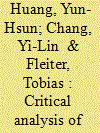|
|
|
Sort Order |
|
|
|
Items / Page
|
|
|
|
|
|
|
| Srl | Item |
| 1 |
ID:
110750


|
|
|
|
|
| Publication |
2011.
|
| Summary/Abstract |
Due to Taiwan's lack of natural resources, dependence on imported energy, and pursuit of sustainable development, renewable energies are extremely important for Taiwan's future energy supply. Since Taiwan's feed-in tariff (FIT) is still in its initial stage, one must examine whether the current system is compatible with a well-designed FIT scheme. This study examines the main features of Taiwan's FIT system and assesses design options using several criteria. Additionally, one of the most important elements of a FIT scheme, namely, a tariff system, is discussed. Taiwan's FIT scheme has the design options required by well-functioning FITs, and the guaranteed-return tariff system coincides with the spirit underlying leading global FITs; however, many issues, such as setting goals by stages, refinement of the tariff calculation methodology, and elimination of other non-economic barriers, must be addressed to achieve future developmental goals and green industry growth.
|
|
|
|
|
|
|
|
|
|
|
|
|
|
|
|
| 2 |
ID:
149964


|
|
|
|
|
| Summary/Abstract |
The cement industry is the second most energy-intensive sector in Taiwan, which underlines the need to understand its potential for energy efficiency improvement. A bottom-up model-based assessment is utilized to conduct a scenario analysis of energy saving opportunities up to the year 2035. The analysis is supported by detailed expert interviews in all cement plants of Taiwan. The simulation results reveal that by 2035, eighteen energy efficient technologies could result in 25% savings for electricity and 9% savings for fuels under the technical diffusion scenario. This potential totally amounts to about 5000 TJ/year, of which 91% can be implemented cost-effectively assuming a discount rate of 10%. Policy makers should support a fast diffusion of these technologies. Additionally, policy makers can tap further saving potentials. First, by decreasing the clinker share, which is currently regulated to a minimum of 95%. Second, by extending the prohibition to build new cement plants by allowing for replacement of existing capacity with new innovative plants in the coming years. Third, by supporting the use of alternative fuels, which is currently still a niche in Taiwan.
|
|
|
|
|
|
|
|
|
|
|
|
|
|
|
|
|
|
|
|
|